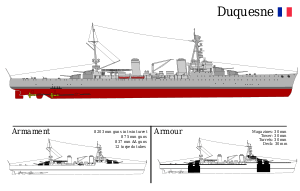Duquesne-class cruiser
The Duquesne class was the first class of post Washington Treaty heavy cruisers built for the French Navy. They have been criticised by naval architects for having very little armour and being lightly built.[1] However, they were considered to be good steamers and seaworthy vessels which could maintain 30 knots (56 km/h; 35 mph) indefinitely at half power.[2]
 Duquesne in her 1939 configuration | |
| Class overview | |
|---|---|
| Name: | Duquesne class |
| Operators: |
|
| Preceded by: | Duguay-Trouin class |
| Succeeded by: | Suffren class |
| Built: | 1924–1928 |
| In service: | 1928–1950 |
| In commission: | 1928–1950 |
| Completed: | 2 |
| Retired: | 2 |
| General characteristics | |
| Type: | Heavy cruiser |
| Displacement: |
|
| Length: | 191 m (626 ft 8 in) overall |
| Beam: | 19 m (62 ft 4 in) |
| Draught: | 6.32 m (20 ft 9 in) |
| Installed power: |
|
| Propulsion: | 4 shafts; geared steam turbines |
| Speed: | 33.75 knots (62.51 km/h; 38.84 mph) |
| Range: | 4,500 nmi (8,300 km; 5,200 mi) at 15 knots (28 km/h; 17 mph) |
| Complement: | 605 |
| Armament: |
|
| Armour: |
|
| Aircraft carried: | 2 GL-812 (superseded by GL-832 then Loire-Nieuport 130, 1 catapult |
| Notes: | [1] |
Design and description
The design of the Duquesne class was derived from an enlarged version of the Duguay-Trouin-class light cruiser armed with 203-millimetre (8 in) guns. The ships had an overall length of 191 meters (626 ft 8 in), a beam of 19 meters (62 ft 4 in), and a draft of 6.45 meters (21 ft 2 in). They displaced 10,160 metric tons (10,000 long tons) at standard load and 12,435 t (12,239 long tons) at deep load. The hull was divided by 16 bulkheads into 17 watertight compartments. Their crew normally consisted of 605 men and increased by 32 when serving as flagships.[3]
Ships
| Ship name | Launched | Commissioned | Decommissioned | Fate[1] |
|---|---|---|---|---|
| Duquesne | 17 December 1925 | 6 December 1928 | 1950 | Condemned, 2 July 1955 |
| Tourville | 24 August 1926 | 1 December 1928 | 1950 | Condemned, 8 March 1962 |
History
Duquesne spent the opening months of World War II assigned to one of the South Atlantic hunting groups searching for the pocket battleship Admiral Graf Spee, while Tourville searched for German ships in the Mediterranean Sea. Both ships were assigned to Force X in the Mediterranean following the Italian declaration of war, and were "demilitarized" in Alexandria harbor from 1940 through mid-1943. Both were then refitted in the United States, landing their torpedo tubes, catapults and aircraft, and being given an augmented anti-aircraft armament of eight Bofors 40 mm guns and sixteen Oerlikon 20 mm cannon.[1] They patrolled the mid-Atlantic for Axis blockade runners; but their anti-aircraft protection was still considered inadequate to provide gunfire support for the invasion of Normandy. Duquesne was part of the French Naval Task Force formed in December 1944 to bombard pockets of German resistance on the French Atlantic coast; and both ships participated in the French reoccupation of French Indochina in 1946.[4]
 Duquesne in original anti-surface layout
Duquesne in original anti-surface layout Tourville after refit: reinforced anti-air armament, removal of sea plane, torpedo launchers and aft mast
Tourville after refit: reinforced anti-air armament, removal of sea plane, torpedo launchers and aft mast-_SLV_H91.325-30.jpg) Tourville in 1929
Tourville in 1929
Notes
- Whitley, pp. 29–31
- le Masson, pp. 91–93
- Jordan & Moulin, pp. 44, 47
- Auphan & Mordal, pp. 292, 318, 351–354, 368
References
- Auphan, Paul; Mordal, Jacques (1959). The French Navy in World War II. Westport, Connecticut: Greenwood Press.
- John Jordan, Duquesne and Tourville: The First French Treaty Cruisers in Warship 2005. Conway Maritime Press 2005. ISBN 1-84486-003-5
- Jordan, John & Moulin, Jean (2013). French Cruisers 1922–1956. Barnsley, UK: Seaforth Publishing. ISBN 978-1-84832-133-5.
- le Masson, Henri (1969). Navies of the Second World War: The French Navy 1. Garden City, New York: Doubleday & Company.
- Anthony Preston - The World's Worst Warships. Conway Maritime Press (2002) ISBN 0-85177-754-6
- Truebe, Carl (September 2017). "Question 26/45". Warship International. LIV (3): 184, 186. ISSN 0043-0374.
- Whitley, M. J. (1995). Cruisers of World War Two: An International Encyclopedia. London: Arms & Armour. ISBN 1-85409-225-1.